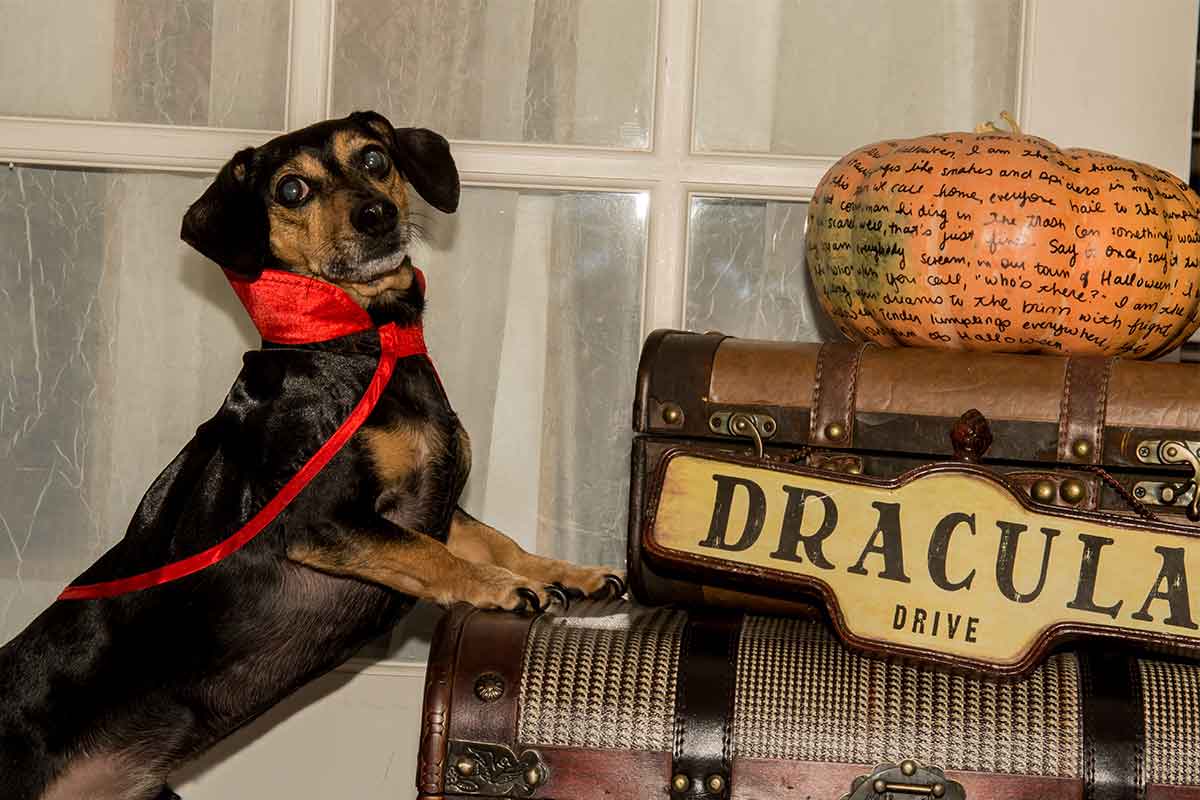Many pets never received the memo that Halloween is supposed to be fun. They truly are spooked by all those creatures that smell like humans but resemble zombies or superheroes. And for many pets the constant ringing of the doorbell and all the commotion is disturbing.
For two reasons, ensconcing those animals in a room behind a closed door is a really good idea. If sequestered in the basement or a bedroom, there’s no concern about the pet bolting out the front door. This is a real issue, as many pets are reported lost around Halloween. Also, it allows you to better manage the fear, anxiety, and stress many animals are feeling.
Think about it. No one wants their pets to feel afraid – even on Halloween. The good news is that you can do something about it, which is what Fear Free is all about. It all begins a few days before Halloween.
Better Living Through Chemistry
Plug in pheromone diffusers in the room the pets are in most often, especially the room you choose as the sanctuary room when trick or treaters begin to ring the doorbell. Adaptil diminishes anxiety in dogs and Feliway Classic is the pheromone product for cats.
Feliway Classic is a copy of the comforting pheromone deposited by cats when they rub their cheeks against your leg or a table leg. The cats are essentially communicating “This is my world and welcome to it.”
Adaptil is a copy of the calming pheromone secreted from the mammary tissue of mother dogs nursing puppies.
Using copies of these pheromones is an easy and natural way to take the edge off, helping to keep pets comfortable in their own environment.
In the room where the pet is sequestered, close any windows so pets don’t hear rowdy trick or treaters, and so the pheromone trail doesn’t drift out the window.
Pump Up The Sound
Turn on your favorite talk radio station or play relaxing music as background sound.
These days, there’s even soothing music specially produced for pets. The leader in the industry is ICalm, which includes various packages and types of tunes designed to calm dogs or cats.
Could it be that dogs are a little bit rock ‘n roll, and cats may be a little bit country? Actually, it’s the classical music genre that seems to be most relaxing for dogs and cats. Many pre-recorded choices are available or just play your own favorite classical music CDs. Or even reggae. One study suggests that reggae music is most preferred by dogs (which gives an entirely new meaning to “Marley and Me”).
Distraction Action
Distraction is a smart strategy. Stuff treats or kibble or moist food into a Kong toy or any of the myriad of food-dispensing toys on the market. If your dog or cat (yes, cats, too) are working on figuring out how to get the yummies, they won’t be simultaneously anxious about the noisy trick or treaters. (Warning: This method isn’t a good idea when pets are aggressive in confined space about sharing food and/or toys.)
When a family member is available, distract with a favorite game – that’s often an effective distraction, such as playing squeaky toy with a dog or using an interactive toy (fishing pole-type toy with feathers) to engage a cat.
If you’re unable to distract your pet and that background music won’t do the trick, there’s nothing wrong going a step further – supplements or medication may be the most humane solution for canine or feline nervous nellies. Nutraceuticals (foods or nutrients with medical benefits) are a great place to begin and can be acquired online or through your veterinarian.
- Zentrol is a proprietary blend of plant extracts. Studies have demonstrated that this chewable can lower fear, anxiety, and stress. Studies have also demonstrated that dogs exhibit fewer “negative behaviors” resulting from fear, anxiety, and stress. Some suggest their dog is “acting out,” when, in fact, the dog is anxious.
- Zylkene demonstrates that grandma was right about a glass of warm milk being relaxing. It contains bovine-sourced hydrolyzed milk protein, an ingredient that has calming properties
For dogs specifically terrified of loud noises, speak with your veterinarian about a prescription pharmaceutical called Sileo (dexmedetomindine oramucosal). The first FDA-approved medication for noise aversion related to fear and anxiety, it’s a quick-acting oromucosal gel (meaning it is applied to the pet’s gums).
If you describe your pet as afraid all the time, talk with your veterinarian or contact a certified applied animal behavior consultant or a veterinary behaviorist. Never punish or holler at your pet for being afraid; that will only have the opposite of the desired effect and create more fear, anxiety, or stress.
Have a safe and Happy Halloween.
This article was reviewed/edited by board-certified veterinary behaviorist Dr. Kenneth Martin and/or veterinary technician specialist in behavior Debbie Martin, LVT.








